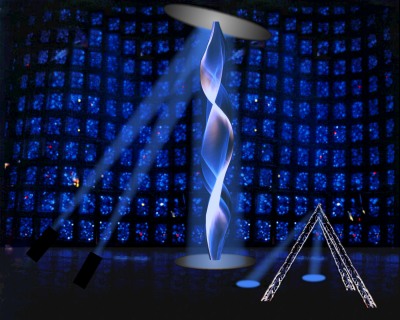PHYSICS TODAY
April 1998
New York Exhibition Marries Art and Science
LightForms '98, an exhibition of interactive, light-based art, opens this month
at the New York Hall of Science. Organised by the non profit group Art &
Science Collaborations Inc (ASCI), the show features three large-scale installations
chosen for both their scientific and aestheitc appeal.
British artist Paul Friedlander's "Dark Matter" is one of the featured
works. "I'm an interdisciplinary person by nature," says Friedlander,
who holds bachelor's degrees in both physics and fine art. "I see my work as exploring the areas
of contact between art and science." As seen in the computer-rendered image
at right, the central element of "Dark Matter" is an undulating vaporous
waveform that rises seven meters from the floor. Friedlander created the effect
by illuminating a spinning rope with a high-power arc lamp reflected off a mylar
mirror. The arc lamp (on loan from the rock group Pink Floyd) has been configured
to shift color rapidly, in sync with the rope's rotation. When the rope rotates
fast enough (around 600 rpm), the human eye perceives a three dimensional multicolored
image. Visitors's can trigger changes in the sculpture's color and shape by
passing through a pair of SoundBeams, located in the triangular structure at
the lower right.
degrees in both physics and fine art. "I see my work as exploring the areas
of contact between art and science." As seen in the computer-rendered image
at right, the central element of "Dark Matter" is an undulating vaporous
waveform that rises seven meters from the floor. Friedlander created the effect
by illuminating a spinning rope with a high-power arc lamp reflected off a mylar
mirror. The arc lamp (on loan from the rock group Pink Floyd) has been configured
to shift color rapidly, in sync with the rope's rotation. When the rope rotates
fast enough (around 600 rpm), the human eye perceives a three dimensional multicolored
image. Visitors's can trigger changes in the sculpture's color and shape by
passing through a pair of SoundBeams, located in the triangular structure at
the lower right.
"Dark Matter" and the show's other works will be housed in the museum's
Great Hall., a setting that ASCI founder Cynthia Pannucci calls "one of
the most appropriate spaces in the world for light art. Its like a homogenous
cave, or a cathedral." The only natural light entering the 24 metre high
interior is filtered through bits of cobalt blue glass imbedded in the walls.
LightForms '98 will run from 17 April through 31 May; museum interpreters will
be on hand to explain the science underlying each piece. The hall is located
in the Corona Park section of Queens, New York. Information is available at
the museums Web site, http://www.nyhallsci.org,
or by calling 718-699-0005.
Jean Kumagai
 degrees in both physics and fine art. "I see my work as exploring the areas
of contact between art and science." As seen in the computer-rendered image
at right, the central element of "Dark Matter" is an undulating vaporous
waveform that rises seven meters from the floor. Friedlander created the effect
by illuminating a spinning rope with a high-power arc lamp reflected off a mylar
mirror. The arc lamp (on loan from the rock group Pink Floyd) has been configured
to shift color rapidly, in sync with the rope's rotation. When the rope rotates
fast enough (around 600 rpm), the human eye perceives a three dimensional multicolored
image. Visitors's can trigger changes in the sculpture's color and shape by
passing through a pair of SoundBeams, located in the triangular structure at
the lower right.
degrees in both physics and fine art. "I see my work as exploring the areas
of contact between art and science." As seen in the computer-rendered image
at right, the central element of "Dark Matter" is an undulating vaporous
waveform that rises seven meters from the floor. Friedlander created the effect
by illuminating a spinning rope with a high-power arc lamp reflected off a mylar
mirror. The arc lamp (on loan from the rock group Pink Floyd) has been configured
to shift color rapidly, in sync with the rope's rotation. When the rope rotates
fast enough (around 600 rpm), the human eye perceives a three dimensional multicolored
image. Visitors's can trigger changes in the sculpture's color and shape by
passing through a pair of SoundBeams, located in the triangular structure at
the lower right.